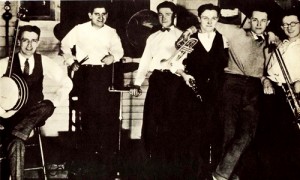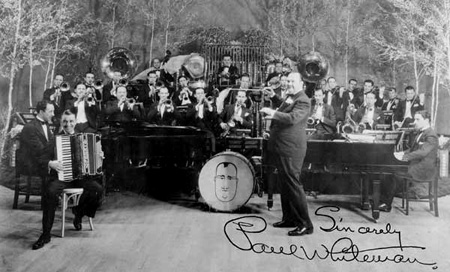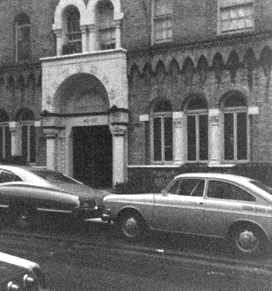Jazz Age cornetist Bix Beiderbecke was born in Davenport, Iowa, in 1903. His brilliant musical career lasted for only seven years; he died of pneumonia at age 28. As a star soloist with the Wolverines and the orchestras of Jean Goldkette and Paul Whiteman, he helped define hot jazz in the 1920s. Bix is regarded by many as one of the most influential jazz musicians of the 20th century.
Bix Beiderbecke was a self-taught genius whose native talent and sheer desire to make music overcame the formidable obstacles presented by the sober, upper-middle-class Midwestern values of his parents.
This week on Riverwalk Jazz The Jim Cullum Jazz Band celebrates the Beiderbecke legacy with live performances of his compositions. Special guest, San Francisco actor Darren Bridgett, reads from rare letters Bix wrote to his friends and family. The letters are published in Bix: The Leon Bix Beiderbecke Story by Phillip R. and Linda K. Evans.

Bix and His Rhythm Jugglers, 1925, Gennett Records studio. Photo courtesy Big Band Database, nfo.net
Writing to his girlfriend, Vera Cox, in 1920, the teenage Bix comes to life:
Received yours of the 8th with much satisfaction as I feared that you would forget one so unimportant as I....I was asked to three parties at which I was to take you but had to take Bunny Hansen at the last resort...I was filled with disappointment, emotion & beer at not being able to take you. ...Tell your grandmother that old friendship is the best and you've decided that I'm about as good as anyone, which I hope is true. Tell her you're coming back to me. Yours anxiously. Say yes.
Bix Beiderbecke didn't have a cornet teacher. He didn't even have a "how to" book or a fingering chart, and by accident developed his unorthodox fingering technique. This unusual self-taught approach to playing and improvising contributed to what later made him unique as a jazz innovator.
By September 1921 Bix's parents enrolled their son at Lake Forest Academy near Chicago, hoping to instill in him discipline and interest in his academic studies. The proximity to Chicago and its budding jazz scene had the opposite effect: Bix formed a small band and played for campus dances.
A year later, after his expulsion from the Academy, Bix began his professional career, working around Chicago and on Lake Michigan excursion boats. He joined the Wolverines in the fall of '23, and the band made its recording debut on the Gennett label. Bix moved to New York, playing with the Wolverines at the Cinderella Ballroom before leaving the Band in 1924.
Saxophone pioneer Frank Trumbauer hired Bix for his band in St. Louis and "Bix and Tram" began their lifelong friendship, working together in Jean Goldkette's band and later with Adrian Rollini's big band in New York. Bix joined Paul Whiteman as a star soloist and toured nationally with him on and off until 1929 when his poor health forced him to quit. He died in New York in 1931 and is buried in Davenport, Iowa.
The list of trumpeters/cornetists directly influenced by Bix's playing is a long one and includes such diverse figures as Jimmy McPartland, Bobby Hackett, Red Nichols, Rex Stewart, Tom Pletcher, Jim Cullum, Jr. and Miles Davis.
Photo credit for home page teaser image: 1925 Gennett Recording, "Davenport Blues." Image courtesy Bixography.com
Text based on Riverwalk Jazz script by Margaret Moos Pick ©2008





